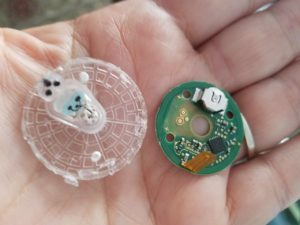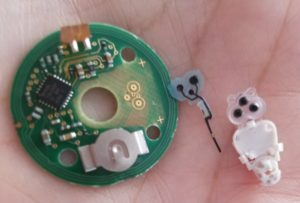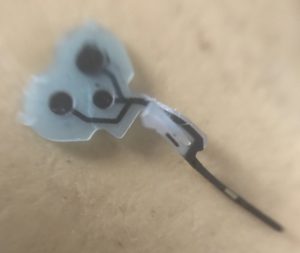continuous blood glucose monitor are nothing short of a true wonder. for people with diabetic it is a enormous help in keeping their health. the continues knowledge of your blood sugar level is overwhelming even to those who’ve been constantly fighting the disease, and makes it easy to check trends and influences on your body.
Current devices takes a measurement every 15 minutes and store all that information. Then with a scan of the reader (or even your cellphone, if you’re willing to void warranty) it’s all downloaded and displayed.
Unfortunately, my wife got Type I diabetes, so she’s using the Freestyle Libre sensor. Each sensor works for 2 weeks and then disables itself, so it needs to be replaced.
One day, I took one unit and dismantled it into pieces.
The design is very minimal: A battery, one chip, the sensor and an antenna.
What surprised me is the battery. It is a simple coin battery, and it’s not even soldered to the pcb. I thought it might be because of a tab, like the one used in toys to save battery until the device is unboxed. But I could not find nothing like that.
The chip is labeled RF430FRL152H, and a short googling finds out it is an “(ACTIVE) NFC ISO15693 Sensor Transponder With SPI/I2C Interface and 14-Bit Sigma-Delta ADC”.
That also explains the small antenna.
The sensor itself is where the magic happens. It is located in a white housing with rubber contacts that connects it to the pcb.
ny the way, contrary to popular belief, the constant pricking while being a nuisance, is definitely not the worst part of the the treatment. you get used to it quite quickly. But not having to do it is a joy.





כיף לקרוא ולהבין את רוב מה שאתה אומר.
ואחרי הפירוק – יש מסקנות של הוזלת המתקן הזה?
LO QUE INDICAS NO ES LA ANTENA LA ANTENA ESTA IMPRESA EN EL PCB SON LOS SURCOS CIRCULARES EN EL BORDE
The little flex ribbon is a temperature sensor. The reading is inaccurate if it is outside of a specific temperature range. What number is on the battery?
SR626SW 0%Hg
There’s not that much to it. Just a probe, an ohmmeter, A/D converter, very small amount of memory and a digital BT transceiver. Except for the probe and packaging, it’s less sophisticated than a Walmart Premier Blu glucose meter. The Libre 2 sensor has more room inside its package, the improvement is primarily in its chip and firmware.
Nearly all iCGM sensors are very similar to a BG self-testing strip, with an oxidizing chemical reaction causing a change in electrical a weak electrical current. None of them accurately indicate BG levels. Even with “calibration” they’re only accurate for one stnbek BG level. They are only useful for seeing rough changes in magnitude and direction of changes, which is barely sufficient to keep a closed loop system stable when close to the desired condition at startup. “No more fingersicks” not realistic for iCGMs, it’s a marketing myth.
The sensor life is limited by the amount of chemical coating on the probe and the amount of glucose in the intertitial fluid. It could last longer for a person with low and steady BG than for one with chronically high, so the sensor life is a conservative compromise between battery size, Bluetooth wake cycles, and probe life. If the probe had a larger supply of reactant or its dispersal rate could be slowed ,the sensor life coud be extended to the battery capacity or the max that the FDA would permit .